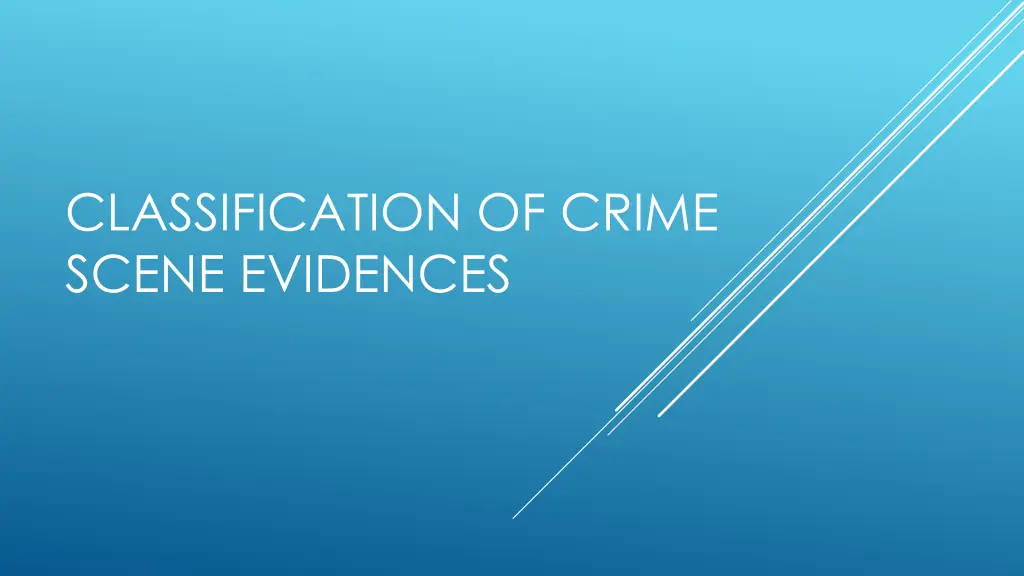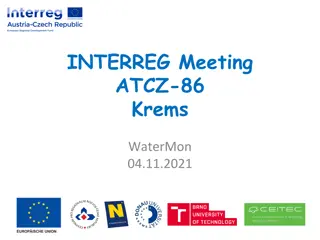
Importance of Trace Evidence and Locard's Exchange Principle in Crime Scene Investigation
Learn about the significance of Locard's Exchange Principle in forensic science, the role of trace evidence in criminal investigations, and the importance of physical evidence at crime scenes. Discover how every contact leaves a trace, aiding investigators in solving cases.
Uploaded on | 0 Views
Download Presentation

Please find below an Image/Link to download the presentation.
The content on the website is provided AS IS for your information and personal use only. It may not be sold, licensed, or shared on other websites without obtaining consent from the author. If you encounter any issues during the download, it is possible that the publisher has removed the file from their server.
You are allowed to download the files provided on this website for personal or commercial use, subject to the condition that they are used lawfully. All files are the property of their respective owners.
The content on the website is provided AS IS for your information and personal use only. It may not be sold, licensed, or shared on other websites without obtaining consent from the author.
E N D
Presentation Transcript
CLASSIFICATION OF CRIME SCENE EVIDENCES
LOCARDS PRINCIPLE Locard s principle of exchange was evolved in the early 19th century and it still plays an important role in tracing the evidence in a crime scene even with all development in technologies and equipment that are used to investigate. Dr. Edmond Locard (1877 1966) was a pioneer in forensic science who became known as the Sherlock Holmes of Lyon, France. He formulated the basic principle of forensic science as: "Every contact leaves a trace". It is generally understood as "with contact between two items, there will be an exchange.
Locards principle is significant and is very relevant in criminal law and most of the crime scene investigation works according to this principle and it does not lose its importance in criminal law and duty of the investigator to find out the trace left by the contact, with its size not being relevant. Though it has few drawbacks, it is logical for contact to leave a trace in the crime scene and biological evidence like DNA or fingerprints has more chances to leave its trace and the investigator has to find the trace to have its relevancy in criminal law even for the future like in the present scenario. A forensic team will have to update its way to examine the crime scene by using new methods because the evidence is tough to find in a crime scene every day. However, the Exchange Principle is the basic root of criminal law and will have its relevancy forever.
The importance of trace evidence and Locards Exchange Principle is probably best described by Paul L. Kirk: Wherever he steps, whatever he touches, whatever he leaves, even unconsciously, will serve as a silent witness against him. Not only his fingerprints or his footprints, but his hair, the fibres from his clothes, the glass he breaks, the tool mark he leaves, the paint he scratches, the blood or semen he deposits or collects. All of these and more, bear mute witness against him. This is evidence that does not forget. It is not confused by the excitement of the moment. It is not absent because human witnesses are. It is factual evidence. Physical evidence cannot be wrong, it cannot perjure itself, it cannot be wholly absent. Only human failure to find it, study and understand it, can diminish its value.
PHYSICAL EVIDENCES What Is Physical Evidence? Physical evidence refers to any material objects that may be present at the scene, at the victims, or found on the suspect. Tracing evidence refers to the physical evidence available in small but measurable amounts, such as hair follicles, strands, or skin cells. The evidence gathered at the scene is analysed and the results used in a criminal investigation to prove or disprove the facts of the case. Physical evidence can be considered as : Corroborative evidence, often confirming or supporting criminal theory, Circumstantial evidence, which indirectly gives a certain conclusion about crime. They are also called real evidence and are indirect types of evidence, which include tangible subjects such as hair, strands, hidden finger and foot traces and other biological and chemical elements.
Types Of Physical Evidence Paint: physical and chemical analysis of paint evidence (chips or residues) may indicate its class, such as car paint, house paint, nail paint, etc. Proof of paint can also show individual characteristics if the investigator is able to find similarities between two samples, such as colour, number of layers, chemical composition, or actual similarity between the edges of two paint chips, one from a tool and one from crime scene. Most of the evidence for painting comes from crimes involving hit-and-run cases. With a controlled sample comparison sample, the paint can be compared to a car with almost 100% certainty. Glass Pieces: Windows or glass windows, particles, or fragments found or transferred to a person or object involved in crime may be strong evidence. Such evidence, whether broken by a bullet or otherwise, helps to determine its colour, features, brightness, density, chemical composition, and refractive index. The test results provide clues about the crime and help investigators to link evidence with the suspect or other object used in the crime, such as matching glass from the crime scene to the suspect's car light. In addition, a lower surface is usually found for fingerprints and / or blood to be present in broken glass.
Explosives And Petroleum Products: Explosive and petroleum products are equipment that contains explosive charge, as well as all substances released from an explosion or heat source that is likely to contain residual petroleum material. The presence of these elements becomes an important factor in determining where a fire or explosion originated and where it continued. For which appropriate collection and analysis helps determine the chemical composition of such materials that can help identify the origin and users of the material. Traces of explosives found on clothing, skin, hair, or other items of the suspect may be likened to explosives from a crime scene.
Ballisitcs: Guns, as well as ammunition or incomplete ammunition, are often the most important evidence in any shooting investigation. In fact, it is almost impossible to obtain a conviction for shooting cases without the discovery of such evidence. If anyone is accompanied by a suspected weapon, a bullet wound, or a case of a broken cartridge can be compared to a weapon and a fingerprint can be compared to a finger. The characteristics of ammunition, firearms and ammunition are examined to determine the similarities between the suspects and the evidence available at the scene.
Fracture Matches: When an object is broken, torn, or cut, two distinct edges are formed, called cracks. These ends can be compared with the naked eye or microscope to see if they fit together, indicating that they may have been part of the same object at the same time. Investigators may compare a piece of tape pieces, pieces of glass, pieces of paint, pieces of car accident, paper bag, etc. to find the same potential Soil And Natural Resources: Any material (clothing or footwear) that contains soil, wood, natural resources such as minerals or other organic matter can help to link a person or thing to a particular place (for example, sandals embedded in a shoe and the vault insertion found in a garment). Many such samples do not prove to be identical, but it is possible by the presence of a rare object. Such types of evidence are often regarded as rare, but they are useful in supporting other evidence.
Questioned Documents: Any document in question, whether handwritten or handwritten, is sent to the laboratory for authenticity and source. These types of analysis are widely used for ransom notes, suicide notes, death threats, and fraud. When typewriters were used, it was easy to compare the typewriters with the products they produce. With the advent of inkjets and laser printers, comparing printed texts is almost impossible. . Summarizing other types of work in document fragmentation include fraudulent acquisition and replacement; handwriting comparisons; reconstruction of damaged documents; identify and compare printers, typewriters or copies used to produce text. Inspectors will analyse a ransom note or other document to obtain clues to link it to the crime scene or to a specific suspect. they will analyse the type of paper used, the printing method or handwriting method, and the type of ink.
Impression Evidence: 3D impressions naturally include tool marks, tire marks, shoe or footprints, compression of lost or soft soil, and all other types of track ideas, and markings on the skin or on various types of food . Shoe stamps and tire tracks: The resulting evidence may be captured, taped, or cast to match the suspect's shoes or tires. Investigators will examine the evidence to identify the type of shoe or tire based on its tread pattern and other visible features to provide clues to the case. Shoes and tires will also show patterns of wear after being used for some time as well as other features (scratches, nicks, cuts) that can be used to match the evidence with certain items. for example, shoe stamps can be compared to a suspect based on the way the shoes are worn because of the person's style of walking .
Bite Marks Each of the 32 teeth in humans is different due to age and aging. Impressions and images of the bite marks left on the victim, attacker, or other object at the scene can often be associated with dental records. Tool marks Small nicks and chips form on the edges of the tool as it is used, which can be used to identify similarities between the evidence and the suspects. Tools may also pick up blood stains or other items that can be tested or have raised fingerprints that can be raised.
Blood, Organ, And Other Physiological Fluids: Blood and body fluids (semen and saliva) will be tested for biochemistry and other analyses to determine your identity and origin and then your identity. By checking the amount, colour, and distribution of such liquids, the investigator may be able to predict several times what happened at the scene. A smear may indicate an attempt to clean or drag the body. Toxicology tests may also identify the possible presence of a drug, alcohol, or poison Blood type, used to exonerate innocent people and identify potential suspects or victims, is still a useful tool. However, recent advances in techniques, tools, and collection processes have increased DNA testing into more common species.
Fingerprints: It is generally known that when a person touches a subject with his or her hands (according to Locard's exchange system) that the printing fingers are left behind. In the past, matching these prints required a narrow field for the suspects, but with the use of computers and a large database, identifying the suspect's documents has become common place. Investigators also identified unique features of the ridge on fingerprints that could be used to identify a suspect or a victim. Hairs And Fibers: hair and strands may be transferred from the suspect or the suspect's clothes to the victims and vice versa. For example, a suspect might take strips of carpet from his shoes or leave his hair behind in a crime scene. Hair can be examined to determine its origin, such as a human or an animal. Root hairs may be complete without DNA testing. Fibres are used to make clothes, carpets, furniture, beds, and bedding. It may be natural fibres from plants or animals or man-made synthetic fibres.
Wounds: Wounds can often be likened to weapons or Armor on a weapon. Investigators may also be able to determine the size, shape, and length of a weapon. Wound analysis may provide indications of the victim's injury, the characteristics of the suspect (left hand, right, height, etc.), and the position of the victim and the suspect at the time of the incident.
TRACE EVIDENCES Introduction At a crime scene, there are often tiny fragments of physical evidence such as hairs, fibers from clothing or carpeting, or pieces of glass that can help tell the story of what happened. These are referred to as trace evidence, and can be transferred when two objects touch or when small particles are disbursed by an action or movement. For example, paint can be transferred from one car to another in a collision or a hair can be left on a sweater in a physical assault. This evidence can be used to reconstruct an event or indicate that a person or thing was present
The importance of trace evidence in the context of crime scene investigation is sometimes understated, taking a back seat to more individualized evidence such as DNA or fingerprints. Trace evidence can include a wide variety of materials, but the most commonly tested are hair, fibers, paint and glass. Other, less frequently included items are soil, cosmetics and fire debris.
An examination for trace evidence could happen at a crime scene, on victims or suspect s clothing, or a location the victim or suspect may have been recently. For example, trace examiners may look for ligature fibers in the case of a strangling to identify what might have been used to commit the crime, or gunshot residue around a bullet hole to indicate the distance between a shooter and a victim. The body, clothing and jewelry of a crime victim are investigated for trace materials using the same precision methods as would be used at a crime scene. In the investigation of a crime scene, investigators must prioritize what items will be collected and sent to the lab, and in what order it should be processed. Investigators using a holistic approach to the scene will gather evidence and prioritize each item by assessing its value based on the level of identification it may provide
Trace examiners use tools such as tweezers, tape, specialized vacuums, swabs, alternate light sources, and lasers to find and collect trace evidence. Following the principles of proper crime scene investigation, the collected materials are packaged, documented and sent to a crime laboratory for analysis.






















